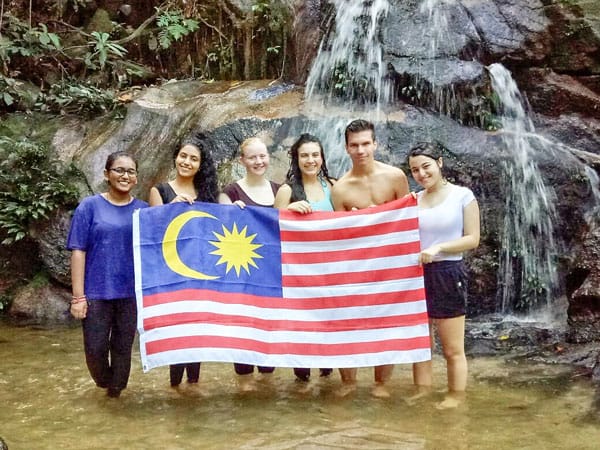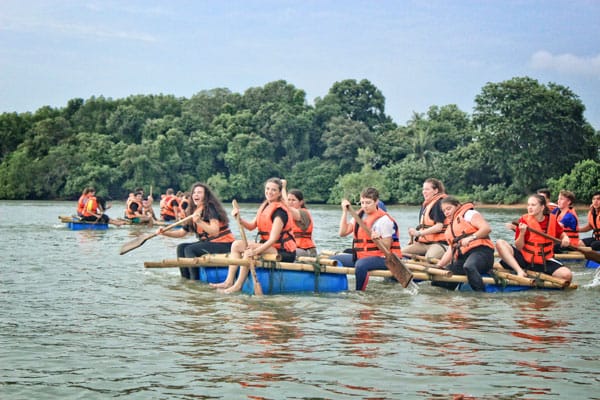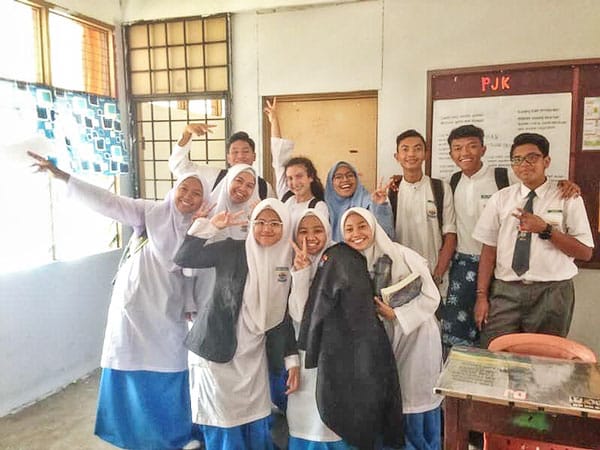Junior year in Malaysia: pines to palms (Part one of a two-part series)

From left to right, volunteer Nisha Thiruchelvam (Malaysia) and students Rury Hmaidan (Italy), Jamain Bauer (Germany), Maria Pangalos (USA), Matteo Sahuc (France), and Noemi Giglio (Italy), pose with the Malaysian flag at their AFS orientation camp in the jungles surrounding Kuala Lumpur.
Article and photos by Maria Pangalos, RCHS intern writer
Junior year of high school typically includes navigating hallways, lockers, gym class, prom, the SAT, college searching and working. If you could go back in time, would you change any of it? Would you swap it all for a fresh start in a new country? I did; I traded in textbooks for real-world issues and pine trees for palm trees. I left the first-world Christian suburbs for a third-world Muslim city. At the age of 16, I moved 9,000 miles away from all things familiar with a suitcase and a plane ticket to my new life; I spent my junior year of high school in Kuala Lumpur, Malaysia.
An exchange year is something I’ve wanted to do for as long as I can remember. In doing research, I learned going on an exchange year is costly. There are, however, various partial and full scholarships offered by parties from the U.S. government to corporations. I applied for the Kennedy-Lugar Youth Exchange and Study (YES) Abroad program scholarship, a fully-subsidized year program sponsored by the U.S. Department of State that sends 65 American students abroad to facilitate cross cultural understanding and better ties between Americans and predominantly Muslim communities. I am honored to say that after much hard work, I was selected as an American diplomat by YES Abroad.
Situated in the heart of the South Pacific, Malaysia has become a melting pot of ethnic and religious diversity. Malay Muslims, Indian Hindus, Chinese Buddhists, and many others have settled throughout Malaysia, cultivating a unique backdrop contingent on harmony. I had the honor of living in the pulsing center of it all: Kuala Lumpur. My lifestyle in Malaysia differed greatly from other expats simply because I did not live like an American; I lived like a Malaysian, with a local Malay family. Living like a local provided insight into the culture and religion in ways not achievable by being a tourist.
AFS students race to capture the flag on rafts they built for part of the mid-stay camp in Port Dickson, Malaysia.
For the duration of my year, I lived primarily with the Malay family, but I also had the opportunity to live with an Indian family and a Chinese family. Malaysia is always celebrating a holiday, whether it be a religious commemoration, a national holiday or a birthday of a Sultan. During some of these massive celebrations, AFS (formerly the American Field Service) sends students to live with a host family of the ethnicity the celebration pertains to. In part two of my story, I will share some of the highlights of celebrating Deepavali in Perak with a wonderful elderly Indian lady and Chinese New Year in Seremban with a Chinese family. My adventures were vast and I hope you return next month so that I can share more.